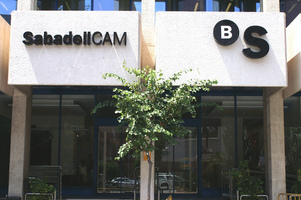Fitch cuts Sabadell to BB+, cites funding challenges, CAM takeover
Wednesday, 1 August 2012
Fitch has cut Banco de Sabadell from BBB to BB+ because of increased risks to the bank’s financial profile stemming from the prolonged recession and real estate crisis in Spain, with the acquisition of Banco CAM also posing challenges.
The rating agency also cut Sabadell’s short term issuer default rating (IDR), from F3 to B, and the bank’s viability rating (VR), from bbb to bb+. The downgrades follow the formalisation of Sabadell’s acquisition of Banco CAM on 1 June after the European Commission approved the takeover.
 Banco CAM is now a 100%-owned bank subsidiary of Sabadell and fully consolidated into the group accounts, with Fitch aligning its IDRs and debt ratings with those of Sabadell, because it considers the bank to be a core subsidiary of the group and it will be legally merged with Sabadell in the fourth quarter of 2012, at which point it will cease to exist as a legal entity.
Banco CAM is now a 100%-owned bank subsidiary of Sabadell and fully consolidated into the group accounts, with Fitch aligning its IDRs and debt ratings with those of Sabadell, because it considers the bank to be a core subsidiary of the group and it will be legally merged with Sabadell in the fourth quarter of 2012, at which point it will cease to exist as a legal entity.
Fitch said that it cut Sabadell’s IDRs and VR to reflect heightened risks to the bank’s financial profile arising from the prolonged recession and real estate crisis in Spain and weakened counterparty/investor confidence in Spain and its banking sector.
“While Sabadell has a good track record of integrating banks,” added the rating agency, “Fitch believes that turning around Banco CAM’s franchise will be challenging in such a difficult climate, given its size and particularly as its deposit franchise deteriorated following its intervention by Spain’s Fund for Orderly Bank Restructuring.”
Sabadell’s acquisition of Banco CAM included a Eu21bn asset protection scheme (APS), net of reserves, covering around one-third of Banco CAM’s assets and a Eu5.2bn capital injection, both granted by Spain’s Deposit Guarantee Fund (FGD). Under the APS, the FGD covers 80% of losses that arise, with Sabadell absorbing the remaining 20%.
Fitch said that most of the downside risk relating to Banco CAM’s poorest quality assets is covered by the APS, while it considers existing reserves held against the stock of group impaired loans to be above average for the sector and, at 85% as of the end of June 2012, likely to be sufficient.
“Fitch’s concerns therefore relate to the impact of Spain’s recession and property crisis on the group’s performing loans not covered by the Banco CAM APS,” it said, “and to the additional risks to earnings arising for example from the need to deleverage and compete for deposits.”
Fitch noted that Sabadell has been able to increase retail funding in recent years, but said that, like many other Spanish banks, it faces funding challenges that stem from intense deposit competition in Spain, a tough deleveraging environment, and Fitch’s expectation that access to public debt markets is likely to remain weak or at best volatile.
“Sabadell has quite a high level of wholesale funding and asset encumbrance,” it added, noting that the group’s central bank funding (equivalent to 14% of total assets) is in part a legacy of pre-acquisition deposit withdrawals from Banco CAM.
The rating agency estimates that around Eu14bn of Sabadell’s central bank funding is used for carry trade purposes, which acts as a useful prop – albeit only temporary – to margins.
Fitch considers the group’s unencumbered liquid assets to represent a moderate buffer against unexpected liquidity shocks, but that they are sufficient to cover the bank’s short term wholesale funds.
The structure of the APS (not pre-funded) also acts as a source of future liquidity when losses are recognised, it said.

